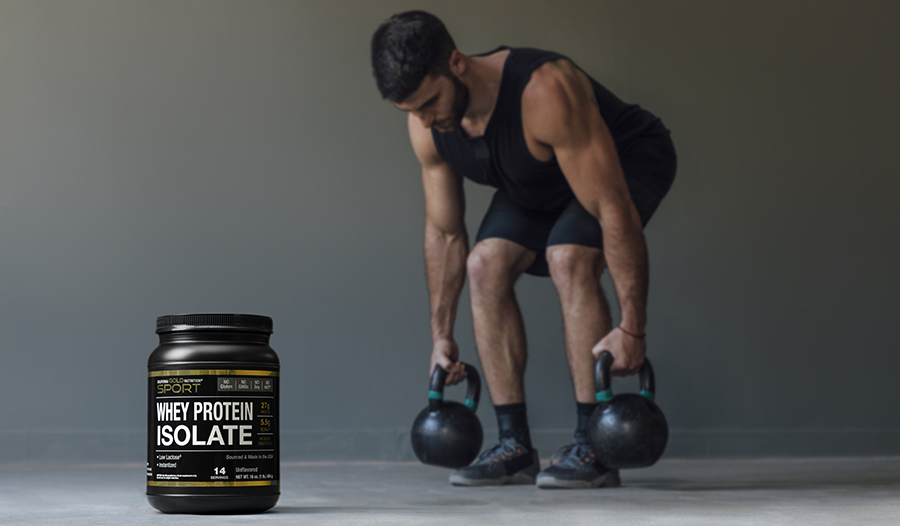How to Build Muscle for Men—Perfecting Your Program
DISCLAIMER:This blog does not intend to provide diagnosis...
- In this article:
- 1. Finding the Right Training Plan
- 2. Dial-In Your Nutrition Plan
- 3. Perfect Your Recovery

In our previous muscle building for men article, we discussed what muscle building is and the basics of muscle building. If you missed that article, make sure to check it out, because it will serve as the framework for this muscle-building article.
There are multiple ways to approach muscle building. What’s most important is that you tackle your goals of building muscle with strategy and a game plan that works for your lifestyle. A useful way to create your muscle-building plan is to truncate different aspects that are required to build quality, lean muscle.
In this article, we’re going to cover actionable steps that you can take to perfect your muscle-building plan. We’ll start with finding the ideal training plan for your goals, then cover nutrition and recovery.
1. Finding the Right Training Plan
When searching for your ideal training plan, it’s important to remember that no plan is perfect. At times, fitness enthusiasts can fall into the trap of always searching for the perfect plan and never really making steady progress due to inconsistency.
Instead of searching for the perfect program, shift your mindset to finding what would be ideal under your current circumstances. The best way to approach the concept of finding what’s ideal is to consider your goals and do your research.
Establish Your Goals
Take a moment and write out your goals for training. Ask yourself, “Why am I working out? What do I want to accomplish?” Once you’ve done this, establish a micro, meso, and macro list of goals.
- Micro: Micro goals are short-term goals that can take about a month or less to tackle. Examples could be going to the gym for a full week straight or following a new nutritional plan for 6/7 days of the week. Micro goals are best served when they’re rooted in processes and habitual changes.
- Meso: Meso goals are intermediate-length goals that last between a couple of months and a year. Examples of meso goals could be hitting new 1-rep maxes, losing 10 lbs, or increasing your lean mass.
- Macro: Macro goals are long-term overarching goals that take extended periods of time to reach. An example could be building a healthy and strong body to play with your kids as they get older. Consider macro goals as the big “why” to your consistent training.
When writing out your training goals, start with 1-4 in each section, and list them in an order that reflects their importance to you. Once you’ve done this, you can then search for a training plan that fits them the best.
What to Look for In a Training Plan
A quality training plan will provide clear, descriptive steps as to how it will assist you with your goals. Three tips that are worth considering when searching for your ideal training plan include:
- Consider frequency: How often can you realistically work out? Frequency is incredibly important because it can play a large role in workout adherence. For example, find a plan that works with your schedule and wants, not just what you think is best. More is not necessarily more, especially if that more leads to you not being able to keep up or follow the plan enthusiastically.
- Assess the modes of training: A workout program needs to include the equipment you have access to and exercises you enjoy performing. Far too often, we hop to training programs that we think are “right” for us based on what we see and read but end up not adhering to them due to not truly loving what we’re doing. Find a plan that includes forms of activity that you like, as this will lead to better adherence.
- Acknowledge timelines and be realistic: To reach most of our meso and macro goals, it takes time and consistency. When searching for a training plan, try to find plans that run for at least a couple of months so you can track your progress more accurately, and assess where to head next. Short workout plans are okay to do here and there, but they’re not the best for assessing trends that we can notice with our body composition and strength following longer plans.
2. Dial-In Your Nutrition Plan
What’s the best nutrition plan? The one you can realistically stick to. This simple mantra gets overlooked far too often. Habits, especially when it comes to nutritional choices, take time to build and acclimate to.
Sharp shifts in your nutritional plan can lead to less adherence, which will only slow your rate of achieving your goals. Here are some awesome tips for tackling a nutritional plan with strategy.
Establish A Caloric Total
Once you’ve established your goals for your body composition and body weight, you can then fill in the blanks with a caloric total and macronutrient breakdown that will support your goals. The best way to find these numbers is to work with a professional, but if that’s not realistic for you, then you can use the following steps.
A great way to establish your current caloric intake is to do the following:
- Weigh yourself in the morning before consuming fluids and foods.
- Track what you consume for 2-3 days (record anything that has calories).
- Weigh yourself each morning before consuming fluids and foods.
If your weight is similar on all the days that you weighed yourself, then you’re likely eating around your maintenance, so you can use the caloric average from your logged days to then create a caloric goal.
- For weight gain: Aim to increase your caloric intake by 300-500 calories every week.
- For maintenance: Eat around a similar amount.
- For weight loss: Aim to decrease your caloric intake by 300-500 calories every week.
A realistic goal for slow, maintainable weight loss is to lose about 1-2 lbs a week.
Assess Your Macros
As for macros, daily totals will vary based on your overarching goals. Macros can vary greatly based on multiple factors.
Baseline starting points can be found below:
- Fat: 20-30% of your daily caloric intake is a good starting point for establishing daily fat macros. Focus on healthy fats like coconut oil, avocados and avocado oil, and chia seeds.
- Carbohydrates: 35-65% of your daily caloric intake is a decent starting point. Focus on whole grains, fruit, and starchy vegetables.
- Protein: 15-35% of your daily caloric intake based on your goals. Populations such as athletes, active individuals, older populations, those trying to lose weight will usually be higher on this percentage. Focus on lean animal protein, or, if you don't eat meat, plant-based protein, and protein powders.
Author’s note: Remember the percentages above will VARY based on your overall goals. Your macros will not look like your peers.
3. Perfect Your Recovery
To progress regularly, you have to make recovery a priority. By providing our body with adequate nutrients, minerals, and sleep on a regular basis we can continually work towards recovering fully after every session.
Sleep is easily the biggest determinant of recovery and growth. This runs especially true for active individuals that are trying to build muscle, lose weight, and get stronger.
If you don’t have one already, it’s a good idea to build a daily sleep flow that will help you wind down and prepare for deep, restful sleep.
Try These 6 Healthy Nightime Habits:
- Find a consistent bedtime that is realistic to stick to.
- Start limiting fluid and food intake when you’re within 60-90 minutes of sleep.
- Limit technology within 30-60 minutes of when your head hits the pillow.
- Consider taking magnesium 30-minutes before sleeping to help you relax.
- Try doing 10-minutes of light yoga and/or meditation to calm down your nervous system.
- Read more before you sleep!
Outside of sleep, there are other things you can do to boost your recovery. Some staples I often recommend are taking Epsom salt or mineral baths regularly, consuming zinc to support the immune system, and upping the vitamin D in the colder months. In addition, many post-workout recovery formulas contain nutrients designed to support muscle restoration. All of these factors can help to provide your body with better recuperation.

 By Jake Boly, CSCS
By Jake Boly, CSCS


